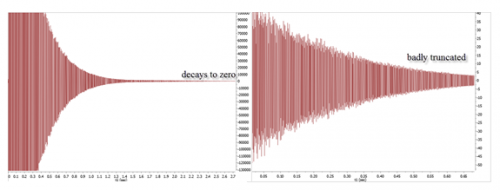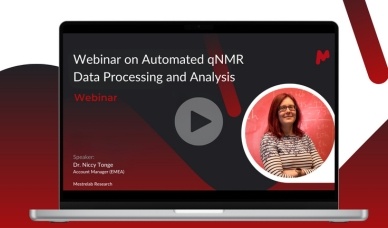qNMR Purity Recipe Book (2 – NMR Acquisition)
The NMR Spectrometer
I will have to be a little vague at times in this section, as specifics will depend on your spectrometer vendor and age.
Temperature
Very good temperature regulation of the sample in the probe is required for the best quality spectra. You should also allow ca. 5 minutes for your sample to temperature equilibrate in the probe before starting shimming and signal acquisition.
Acquisition conditions
You will typically use the simplest pulse sequence—repetitive pulse and acquire:
Relaxation delay — Pulse — Acquire
Interpulse time.
The consideration is that all spins should be at their equilibrium position (fully relaxed) before the next pulse is applied. The sum of the acquisition time and relaxation delay is sometimes called the pulse repetition time, and this number needs to be carefully set up.
The consideration is that all nuclei have fully returned to equilibrium between pulses. If you are using 90° pulses, then this should be at least 5 times the T1 of the proton with the longest relaxation time. If you are measuring the same material every time, it would be beneficial to determine this. It’s worthwhile to determine the T1 of your reference material or solvent under your experimental conditions of temperature, etc., at least once, so that you know the minimum pulse repetition time. You may be surprised by this figure—it is often several tens of seconds!
The issue of pulse repetition rate is often overlooked, and yet it is absolutely fundamental to a good experiment.
Acquisition time.
As mentioned, the interpulse delay is the sum of the acquisition time and relaxation time. But you should consider how you divide this time: a longer acquisition time than you normally use for routine 1H spectra will almost certainly be used.
You want to aim for an acquisition time that is long enough to collect the time-domain FID signal until it has decayed to the point where only noise is being digitized. If you use a shorter acquisition time, the signals will be truncated, and the effect in the time-domain spectrum will be that each peak shows ‘wiggles’ (truncation artifacts) at the base, along with baseline artifacts. This will clearly affect the integration of each signal.
Spectrum digitisation and Peak Digitisation
The acquisition time and sweep width ultimately determine the number of Hz per point in the final spectrum. One level of zero filling can be performed, but the digitization in the spectrum is a very important consideration as it strongly influences the fidelity of the peak integration.
As a rule, we suggest aiming for more than 5 data points per peak if (a) GSD is to be successful and (b) conventional integration is to be accurate. Ignore this rule at your peril—it can significantly affect your reported integrals! The number of points you acquire will depend on the sweep width, of course, but aim for a much longer acquisition time than you usually use, perhaps 10 seconds or longer. You won’t be adding to the experiment time, and with today’s large storage capacities, data storage shouldn’t be a concern!
Number of scans.
Time-averaging is often needed to build an adequate signal-to-noise ratio (SNR). So we need to ensure that the SNR is adequate to support good integration. You should target a SNR of 250:1 or better for any peak that will be integrated for qNMR purposes.
Receiver gain.
As with any acquisition, the receiver gain should be set so the NMR signal fills the digitiser (ADC) as best as is possible whilst avoiding early time points being “clippedâ€. Too small a receiver gain is undesirable, too. Note that automatic setting of the receiver gain must be done using experimental conditions, and may take some time if the interpulse delay is required to be long!
Sweep width.
Choose a sensible sweep width: this would be ca. 20% larger than the separation between the signals at the extremes of the spectrum.
Number of data points.
This will be dictated by the required sweep-width and acquisition time. However, we need to consider the final digitization of each signal in the spectrum: getting this right is crucial to accurate integration. I will come back to this topic in the processing section, but in extreme cases, it may be necessary to collect the spectrum in parts. For typical 1H NMR spectra, you should collect around 64K data points.
Shimming.
I have saved the best for last! For good quantitation, we need good lineshape, and shimming will play a critical role in this. It’s easy to get used to gradient shimming doing the work for us these days, and it works exceptionally well in the majority of cases. But if you only do ‘on-axis’ gradient shimming, remember to check and optimize ‘off-axis’ shim gradients on a regular basis.
A poorly shimmed sample can often result in an unsymmetrical lineshape, and that will cause significant errors for all line fitting methods, including GSD.
Broadband 13C decoupling.
With qNMR you should in principle also integrate the part of the 1H signal away from the central lines. These arise from the 1-bond coupling between the proton and attached 13C. This accounts for 1.1% of the 1H signal area, and the coupling is 135-200 Hz. Collapsing 13C satellites into the central peak has a number of additional benefits because it simplifies the spectrum. Some spectrometers will make this experiment quite easy to perform. But you must be aware that broadband 13C decoupling itself may raise the temperature in the probe quite significantly, and that would affect the lineshape and therefore be undesirable. You can decrease the acquisition time to minimise this effect. Probe and sample heating is often evident if you look at the lock level and see that it decreases during the acquisition time.



